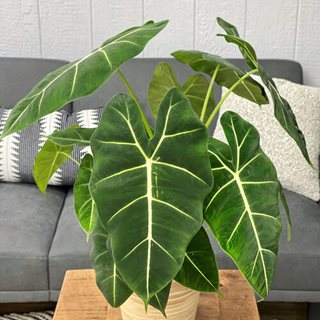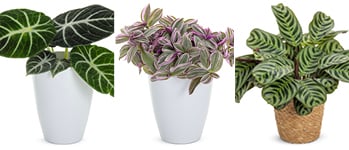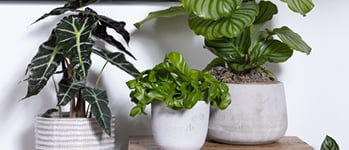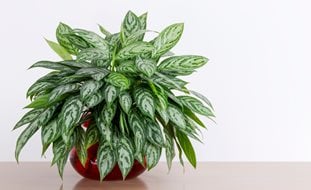How to Grow Alocasia Plants
If you’re looking for a dramatic indoor plant that will bring a touch of the tropics to your indoor space, try alocasia. Get tips for keeping your plants healthy, plus take a look at some popular varieties. Published 6/7/2022
'Frydek' (Alocasia micholitziana 'Frydek'). Photo by: Proven Winners
Flaunting some of the boldest foliage in the houseplant kingdom, Alocasia, or elephant’s ear, joins the ranks of plants like Monstera and Dieffenbachia for its ability to instantly fill a room with leafy lushness. The deeply veined leaves, some growing to more than a foot long, almost look prehistoric because of their intriguing array of reptilian patterns and colors.
Despite their exotic appearance, alocasias will thrive indoors if given optimal conditions. And though some plants can grow to tree-like proportions in their native habitat, you’ll find plenty of varieties small enough to display on a tabletop or in a well-lit corner, allowing you to make elephant’s ear the focal point of any sunny room.
On this page: Basics | Growing Tips | Care | Varieties | Troubleshooting
On this page:
BASICS
Botanical name:
Alocasia spp.
Common names:
Elephant's ear, African mask plant, giant taro
Origin:
Native to subtropical regions of Asia and eastern Australia.
Growth rate:
Fast
Size:
Typically 2 to 6 feet tall and wide when grown as a houseplant. You can also find compact forms, sometimes called “jewel alocasias,” that range in height from 1 to 2 feet.
Foliage:
Heart- or arrow-shaped, sometimes having wavy leaf edges. Colors range from solid to variegated, in shades of gray, green, silver, maroon, or white. Leaf texture can vary too, from smooth and glossy to rich and velvety. Depending on the cultivar, the leaves can be as small as a few inches long to as large as 3 feet in length and width.
Flowers:
May occasionally produce creamy white or light green spathes, similar to those of its aroid cousin, the peace lily.
Are alocasia plants toxic?
Yes! All parts of the plant contain calcium oxalate crystals that are toxic to dogs and cats. The sap can also irritate the skin and eyes. Keep out of reach of children and pets (see this guidance from the ASPCA). Also, wear gloves when handling the plant.
2024 Houseplant of the Year:
GROWING ALOCASIA PLANTS
Light:
Place in a location that receives bright, indirect light, such as near an east- or west-facing window. Keep out of direct sunlight, which can scorch the foliage.
Temperature:
Native to tropical forests and jungles, Alocasia love greenhouse-like conditions, with room temperatures between 65° to 80° F. Keep away from cold drafts, and don’t expose plants to temperatures below 60° F. Also avoid placing near heating or cooling vents.
Humidity:
Like most tropical plants, Alocasia flourish in humid environments and prefer humidity levels of 50% or higher, which can be a challenge to maintain indoors. In drier areas of the home, keep your plants hydrated by using a humidifier, misting the leaves regularly, or setting them on a tray filled with pebbles and water.
Soil type:
Use a loose, well-draining potting mix that has good moisture retention, such as a soilless aroid potting mix. Or amend a regular potting mix by adding perlite to improve drainage, and ground coconut coir for moisture control.

GROWING ALOCASIAS OUTDOORS
Alocasia can be grown in the garden as a perennial in zones 9 to 11 and as a summer annual elsewhere, planted in a location that receives dappled sunlight, such as under a covered porch or tree canopy. If you want to overwinter your plants indoors, grow them in pots and bring them inside if temperatures are expected to dip below 60° F for a prolonged period.
Learn more about growing elephant ear plants in the garden.
ALOCASIA CARE
Watering:
Alocasias are very finicky about their water requirements and don’t like soil that’s either too dry or too soggy. During the active growing season (spring through fall), water regularly to keep the soil evenly moist, or whenever the top layer of soil feels dry to the touch. During the winter, when plants are dormant, water less frequently.
Alocasias are also sensitive to chlorine and other chemicals and minerals in tap water, which can cause leaf spotting. Use distilled or filtered water, or let tap water sit overnight to allow the chemicals to evaporate.
Fertilizing:
Feed with a diluted liquid fertilizer for houseplants once or twice a month during the growing season (spring and summer), withholding fertilizer during the late fall and winter dormancy period. Resume your feeding schedule once your plant returns to life in spring.
Pruning:
Because elephant’s ears are fast-growing, it is normal for older leaves to turn brown and wither as new leaves appear. To keep your plants attractive, remove any dead or discolored foliage by cutting the leaf stalk at its base using a clean knife or hand pruners. Be sure to wear gloves to avoid skin contact with the sap from the cut stems.
Leaf care:
The large leaves of alocasia are great dust collectors. To keep them nice and healthy, clean them often with a damp cloth, which will improve their ability to absorb light. Misting the leaves will also help keep them free of dust buildup.
Repotting:
Alocasia prefers to be slightly rootbound, so repotting is only necessary when you notice the roots pushing through the drainage holes in the bottom of the pot or emerging from the soil surface. Choose a new pot about 1 to 2 inches larger in diameter than the original, preferably a nonporous plastic or ceramic container that won’t wick moisture out of the soil.
Even if you don’t need to repot, it’s a good idea replenish the soil every couple of years to improve plant health.
Propagation:
Because alocasias grow from tuberous rhizomes, the easiest way to propagate them is to divide the rhizomes into sections. Remove your plant from its pot, shake off the excess soil, and gently tease the roots apart to separate the offsets from the mother plant, taking care to leave the root system on each section intact. For the greatest success, propagate your elephant’s ear during the spring or early summer, when the plant is coming out of winter dormancy.
Pests and diseases:
Pests and diseases: Keep an eye out for spider mites, mealybugs, thrips, and aphids. (See more on how to get rid of pests on houseplants.)
Alocasias are also prone to root rot if allowed to sit in soggy soil. Make sure there are sufficient drainage holes in the bottom of the pot so excess water will drain completely.
ALOCASIA VARIETIES
See more Mythic® alocasia plants from the leafjoy® line from Proven Winners.
TROUBLESHOOTING COMMON PROBLEMS: ALOCASIA
- Lopsided growth often means your alocasia is receiving uneven light. To give the leaves uniform light exposure, rotate the pot every time you water. Plants may also lean due to the weight of the oversized leaves. If necessary, use stakes to help keep them upright.
- Scorched leaves are likely the result of exposure to direct sunlight. Although alocasia needs plenty of bright light for healthy foliage growth, the leaves are very sensitive to the sun’s rays and burn easily, even after short-term exposure. One solution is to use a sheer curtain to shield your plant from direct sun.
- Plants may drop leaves when you first bring them home or whenever they are forced to acclimate to a new environment. It's also common for alocasias to drop leaves during their winter dormancy period. Don't panic. Plants usually recover quickly and can fully grow back as long as their root system remains healthy.
- Yellowing leaves can be due to a variety of factors, including improper watering, poor drainage, and lack of light. If you are growing plants in a poorly lit room, move them to a brighter location closer to a window. Also, hold off on watering your plants until the top 1 to 2 inches of soil feels dry.
- Brown leaf tips are usually a sign of insufficient humidity. Remedies include misting the leaves daily, placing your plants near a humidifier, or moving them to a steamy environment, like a brightly lit bathroom.
- If the leaves are drooping you may be underwatering. Give your plant a good drink to revive it and then keep the soil slightly moist, making sure it doesn’t go completely dry between waterings.

















